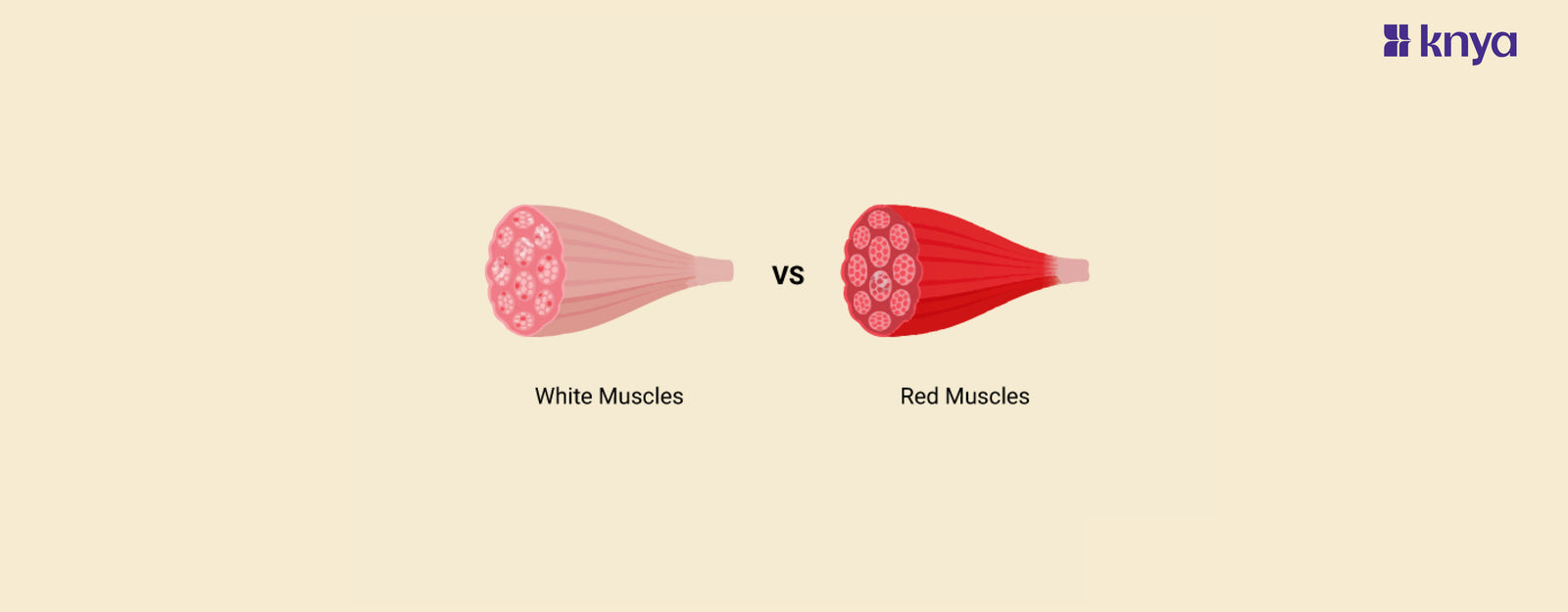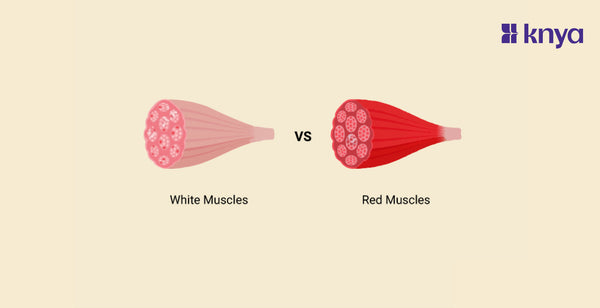Difference Between Red Muscles and White Muscles: Within the intricate world of muscle physiology, the distinction between red muscles and white muscles reveals the diverse nature of our muscular system. These two types of muscle fibers, known for their unique characteristics and functions, play crucial roles in our body's movement and energy metabolism. Here's a brief exploration of the key differences between red muscles and white muscles:
[image_banner]
Difference Between Red Muscles and White Muscles
Here's a concise comparison table highlighting the differences between red muscles (slow-twitch fibers) and white muscles (fast-twitch fibers):
|
Aspect |
Red Muscles |
White Muscles |
|
Muscle Fiber Size |
Smaller in size |
Larger in size |
|
Capillary Density |
Higher capillary density |
Lower capillary density |
|
Myosin ATPase Activity |
Slower Myosin ATPase activity |
Faster Myosin ATPase activity |
|
Mitochondrial Size |
Smaller mitochondrial size |
Larger mitochondrial size |
|
Mitochondrial Content |
Higher mitochondrial content |
Lower mitochondrial content |
|
Glycogen Stores |
Lower glycogen stores |
Higher glycogen stores |
|
Contraction Duration |
Prolonged contraction duration |
Brief contraction duration |
|
Recruitment Order |
Activated earlier in submaximal activities |
Activated later in submaximal activities |
|
Examples of Activities |
Endurance running, cycling, swimming |
Sprinting, weightlifting, jumping |
|
Adaptation to Training |
Respond well to endurance training |
Respond well to strength and power training |
|
Postural Muscles |
Often involved in maintaining posture |
Often not heavily involved in maintaining posture |
|
Muscle Fiber Color |
Reddish due to higher myoglobin content |
Paler color due to lower myoglobin content |
|
Metabolic Pathways |
Primarily aerobic metabolism |
Primarily anaerobic metabolism |
|
Energy Production |
Sustained energy for endurance activities |
Rapid energy for short bursts of intense activity |
|
Fatigue Resistance |
High fatigue resistance |
Fatigue more quickly |
|
Contraction Speed |
Contract more slowly |
Contract rapidly |
|
Activity Suitability |
Well-suited for prolonged, low-intensity activities |
Suited for brief, powerful movements |
|
Vascularization |
Rich network of blood vessels |
Fewer blood vessels |
|
Mitochondria Density |
Higher mitochondrial density |
Lower mitochondrial density |
|
Myoglobin Content |
Higher myoglobin content |
Lower myoglobin content |
Know about Red Muscles
Red muscles, also known as slow-twitch fibers or type I fibers, represent a type of muscle fiber with distinct characteristics that make them well-suited for certain types of activities. Here are key features and information about red muscles:
- Color and Myoglobin Content:
- Red muscles appear reddish in color due to a higher concentration of myoglobin, a protein that stores and transports oxygen within muscle cells.
- Myoglobin facilitates the efficient delivery of oxygen to muscle cells, supporting aerobic metabolism.
- Metabolic Pathways:
- Red muscles primarily rely on aerobic metabolism, which involves the use of oxygen to produce energy.
- This metabolic pathway is well-suited for endurance activities that require sustained muscle contractions over extended periods.
- Energy Production and Fatigue Resistance:
- Red muscles are adapted for sustained energy production, making them highly resistant to fatigue.
- These muscles are suitable for activities such as long-distance running, cycling, and swimming, where endurance and stamina are crucial.
- Contraction Speed:
- Red muscles contract more slowly compared to white muscles (fast-twitch fibers).
- This slow contraction speed is beneficial for activities that require prolonged and controlled movements.
- Vascularization:
- Red muscles are characterized by a rich network of blood vessels, enhancing the delivery of oxygen and nutrients to muscle fibers.
- The increased vascularization supports the sustained energy demands of aerobic metabolism.
- Mitochondrial Density:
- Red muscles have a higher density of mitochondria, the cellular organelles responsible for energy production.
- Mitochondria play a key role in aerobic metabolism and contribute to the endurance capabilities of red muscles.
- Activity Suitability:
- Red muscles are well-suited for activities that involve low to moderate intensity but require endurance.
- They are often engaged in activities related to maintaining posture and supporting the body over prolonged durations.
- Adaptation to Training:
- Red muscles respond well to endurance training, which involves activities that challenge aerobic capacity and stamina.
- Regular endurance training can lead to increased capillarization, improved mitochondrial function, and enhanced endurance performance.
- Examples of Red Muscle Activities:
- Marathon running
- Long-distance cycling
- Swimming long distances
- Postural maintenance during prolonged periods
Understanding the characteristics of red muscles is essential for athletes, fitness enthusiasts, and individuals engaged in specific activities to tailor their training regimens effectively. Training that emphasizes endurance and aerobic capacity can lead to adaptations in red muscle fibers, enhancing overall performance in endurance-related activities.
[image_banner]
Know about White Muscles
White muscles, also known as fast-twitch fibers or type II fibers, represent a distinct type of muscle fiber with characteristics that make them well-suited for activities requiring short bursts of intense power and strength. Here are key features and information about white muscles:
- Color and Myoglobin Content:
- White muscles appear paler in color compared to red muscles due to a lower concentration of myoglobin.
- Myoglobin is less abundant in white muscles as they primarily rely on anaerobic metabolism for energy production.
- Metabolic Pathways:
- White muscles primarily rely on anaerobic metabolism, generating energy without the need for oxygen.
- This metabolic pathway is well-suited for short bursts of high-intensity activities where rapid energy production is essential.
- Energy Production and Fatigue Resistance:
- White muscles are designed for rapid and powerful contractions but fatigue more quickly compared to red muscles.
- These muscles are suitable for activities such as sprinting, weightlifting, and jumping, which involve short, explosive efforts.
- Contraction Speed:
- White muscles contract rapidly, making them well-suited for activities that require quick and forceful movements.
- The fast contraction speed enables the generation of high force in a short amount of time.
- Vascularization:
- White muscles have fewer blood vessels compared to red muscles.
- While they may not rely as heavily on oxygen delivery as red muscles, the reduced vascularization limits sustained endurance.
- Mitochondrial Density:
- White muscles have lower mitochondrial density compared to red muscles.
- Mitochondria are less involved in energy production, as white muscles primarily utilize anaerobic pathways.
- Activity Suitability:
- White muscles are well-suited for activities that demand short bursts of power, strength, and speed.
- They are often engaged in activities requiring explosive movements, such as weightlifting, sprinting, and jumping.
- Adaptation to Training:
- White muscles respond well to strength and power training, which involves activities that challenge maximum force production.
- Resistance training and high-intensity interval training can lead to adaptations in white muscle fibers, improving strength and power.
- Examples of White Muscle Activities:
- Weightlifting
- Sprinting
- Jumping
- Short-duration, high-intensity activities
Understanding the characteristics of white muscles is essential for athletes and individuals involved in activities that demand rapid, powerful movements. Tailoring training programs to include strength and power exercises can optimize the function and performance of white muscle fibers.
Similarity Between Red Muscles and White Muscles
While red muscles (slow-twitch or type I fibers) and white muscles (fast-twitch or type II fibers) have distinct characteristics, there are some similarities between them as part of the overall muscle system. Here are a few points of similarity:
- Muscle Fiber Structure:
- Both red and white muscles are composed of muscle fibers, which are the basic contractile units of skeletal muscle.
- Role in Movement:
- Both types of muscle fibers play essential roles in movement and physical activities, contributing to the overall function of the musculoskeletal system.
- Neuromuscular Control:
- Red and white muscles are both controlled by the nervous system through motor neurons, receiving signals that trigger muscle contractions.
- Ability to Adapt:
- Both types of muscle fibers can undergo adaptations in response to training. Exercise and physical activity can lead to changes in muscle structure and function to meet specific demands.
- Contraction Mechanism:
- Both red and white muscles contract through the sliding filament theory, a physiological process involving the interaction between actin and myosin filaments.
- Dynamic System:
- The distribution of red and white muscle fibers within a muscle allows for a dynamic range of capabilities, from sustained endurance to rapid, powerful contractions.
- Role in Posture:
- Both types of muscle fibers contribute to maintaining posture and stability, with red muscles often playing a role in prolonged postural support.
While these similarities exist, it's crucial to recognize that red and white muscles are specialized for different types of activities. The distinctions in their metabolic pathways, fatigue resistance, and contraction speeds highlight their specific roles in supporting various physical demands. The coexistence and coordination of red and white muscles enable the body to perform a diverse range of movements and activities efficiently.
|
Check out More Articles |
|















